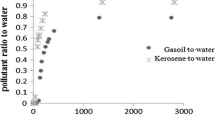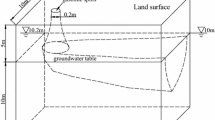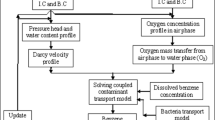Abstract
Soil contamination due to spills or leaks of crude oils andrefined hydrocarbons is a common problem. Estimation of spillvolume is a crucial issue in order to determine the expectedcontaminating life span of contaminated soils. The directprocedure to determine the amount of hydrocarbon in soil is to measure the concentration of total petroleum hydrocarbon (TPH) in soil samples. The primary objective of this study was toassess the potential effects of oil contaminated soils on thewater quality of Devegecidi dam reservoir. For this purpose,limited spill data available were evaluated and soil samplingstudies were conducted in the Beykan oil field to analyze forTPH on oil contaminated soils. Available spill and measured soilTPH data were used in a subsequent modeling study to assess thereservoir water quality impacts due to dissolved mass leachingfrom hydrocarbon contaminated soils. Evaluation of availablespill data between 1989 and 1995 revealed that a total of 252recorded spills resulted in a net spill of 395 tons. The majortypes of oil spills were identified as well heads (WH), returnlines/flow lines (RL/FL), and power oil lines (POL). A total of211 soil samples was collected at selected well heads andanalyzed for TPH in the laboratory. TPH results revealed aconcentration range between 600 and 115 500 mg kg-1 with a meanconcentration of 20 300 mg kg-1. Modeling studies focused onbehavior assessment and involved two major components. The firstcomponent is a soil-leaching submodel for estimating theleachate concentration and contaminant mass leaching out of thecontaminated soil body. The second component is a reservoirwater quality submodel assuming complete-mix conditions forestimating the changes of hydrocarbon concentration in thereservoir water as a function of time. These two components arecoupled via a mass inflow term present in the reservoir waterquality model, accounting for contaminant mass loadingcontributed by the leaching of contaminated soil. Simulation runs performed under conservative conditions assuming an annualaverage oil spill volume of 95 tons and the minimum reservoirvolume of 7.3 × 106 m3 revealed that there isno imminent threat to reservoir water quality from the dissolved phase contaminants soils. Limited amount of availablemeasurements of TPH concentrations in soil samples and benzeneconcentrations in reservoir water samples supported model results.
Similar content being viewed by others
References
Carsel, R. F. and Parrish, R. S.: 1988,‘Developing joint probability distributions of soil water retention characteristics’ Water Resour. Res. 24(5), 755–759.
Chiang, C. Y., Salanitro, J. P., Chai, E. Y., Colhart, J. D. and Klein, C. L.: 1989,‘Aerobic biodegradation of benzene, toluene and xylene in a sandy aquifer: data analysis and computer modeling’ Ground Water 27, 823–834.
Judge, C., Kostecki, P. and Calabrese, E.: 1997, State summaries of soil cleanup standards, Soil and Groundwater Cleanup, November 1997, 10–34.
Jury, W. A., Russo, D., Streille, G. and El Abd, H.: 1990,‘Evaluation of volatilization by organic chemicals residing below the soil surface’ Water. Resour. Res. 26, 13–20.
Loehr, R. C., Martin Jr, J. H. and Neuhauser, E. F.: 1992,‘Land treatment of an aged oily sludgeorganic loss and change in soil characteristics’ Water Research 26, 805–815.
Mercer, J. W. and Cohen, R. M.: 1990,‘A review of immiscible fluids in the subsurface: properties, models, characterization and remediation’ J. of Contam. Hydrol. 6, 107–163.
Millington, R. J. and Quick, J. M.: 1961,‘Permeability of porous solids’ Trans. Fraday Soc. 57, 1200–1207.
N.V. Turkse Shell: 1995, Oil Spillage Reports, Ankara, Turkey.
Parker, J. C.: 1989,‘Multiphase flow and transport in porous media’ Reviews of Geophysics 27, 311–328.
Peng, J., Bewtra, J. K. and Biswas, N.: 1994,‘Volatilization of selected organic compounds from quiescent water’ J. of Environ. Eng. 120(3), 663–669.
Short, E. S.: 1985,‘Movement of Contaminants from Oily Wastes During Land Treatment’ in E. J. Calabrese and P. T. Kostecki (eds.), Soils Contaminated by Petroleum Kluwer Academic Publishers, Dordrecht, pp. 317–330.
Smith, J. H., Bomberger, D. C. and Haynes, D. L.: 1980,‘Prediction of volatilization rates of highvolatility chemicals from natural water bodies’ Environ. Sci. and Tech. 14(11), 1332–1337.
State Hydraulic Works: 1996, Environmental protection project for water resources of the city of Diyarbak?r. Interim Report prepared by the division of DrinkingWater and Sanitary Engineering.
Steffy, D. A., Barry, D. A. and Johnston, C. D.: 1997,‘Influence of antecedent moisture content on residual LNAPL saturation’ J. of Soil Contamination 6(2): 113–147.
Tchobanoglous, G. and Schroeder, E. D.: 1985, Water Quality: Characteristics, Modeling, Modification, Addison-Wesley Publishing Company, Reading, Massachusetts, U.S.A.
Thibodeaux, L. J., Springer, C. and Riley, L. M.: 1982,‘Models of mechanisms for vapor phase emissions of hazardous chemicals’ Journal of Hazardous Materials 7, 63–74.
U.S. EPA: 1996, Test Methods for Evaluating Solid Wastes, Physical/Chemical Methods, SW-846, 3rd ed. Office of Solid Waste and Emergency Response, Washington, D.C.
Ñnlü, K., Kemblowski, M. W., Parker, J. C., Stevens, D., Chong, P. K. and Kamil, I.: 1992,‘A screening model for effects land-disposed wastes in groundwater quality’ J. of Contaminat. Hydrol. 11, (1992), 27–49.
Ñnlü, K. and Parker, J. C.: 1995,‘Estimation of capillary pressure parameter from total petroleum hydrocarbon measurements in contaminated soils’ Turkish J. of Oil and Gas 1(1), 45–51.
Weisman, W. H.: 1998,‘Total petroleum hydrocarbon criteria working group: A risk-based approach for the management of total petroleum hydrocarbons in soil’ J. of Soil Contamination 7(1), 1–15.
Author information
Authors and Affiliations
Corresponding author
Rights and permissions
About this article
Cite this article
Ünlü, K., Demirekler, E. Modeling Water Quality Impacts of Petroleum Contaminated Soils in a Reservoir Catchment. Water, Air, & Soil Pollution 120, 169–193 (2000). https://doi.org/10.1023/A:1005294109979
Issue Date:
DOI: https://doi.org/10.1023/A:1005294109979




